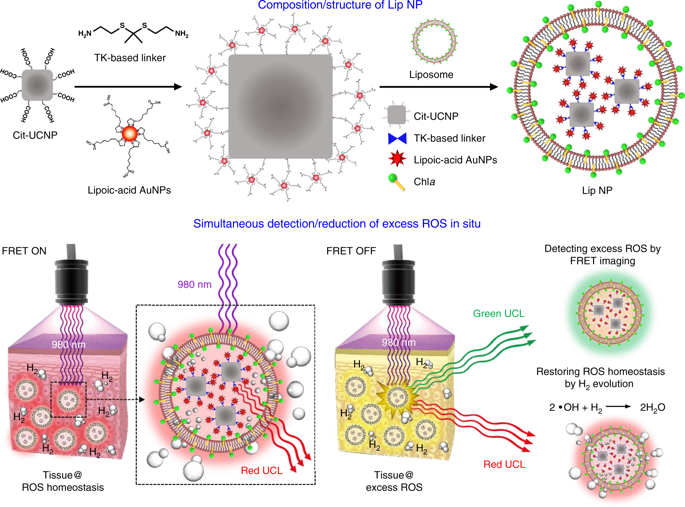当前位置:
X-MOL 学术
›
Nat. Commun.
›
论文详情
Our official English website, www.x-mol.net, welcomes your
feedback! (Note: you will need to create a separate account there.)
Photosynthesis-inspired H2 generation using a chlorophyll-loaded liposomal nanoplatform to detect and scavenge excess ROS.
Nature Communications ( IF 14.7 ) Pub Date : 2020-01-27 , DOI: 10.1038/s41467-020-14413-x Wei-Lin Wan,Bo Tian,Yu-Jung Lin,Chiranjeevi Korupalli,Ming-Yen Lu,Qinghua Cui,Dehui Wan,Yen Chang,Hsing-Wen Sung
Nature Communications ( IF 14.7 ) Pub Date : 2020-01-27 , DOI: 10.1038/s41467-020-14413-x Wei-Lin Wan,Bo Tian,Yu-Jung Lin,Chiranjeevi Korupalli,Ming-Yen Lu,Qinghua Cui,Dehui Wan,Yen Chang,Hsing-Wen Sung

|
A disturbance of reactive oxygen species (ROS) homeostasis may cause the pathogenesis of many diseases. Inspired by natural photosynthesis, this work proposes a photo-driven H2-evolving liposomal nanoplatform (Lip NP) that comprises an upconversion nanoparticle (UCNP) that is conjugated with gold nanoparticles (AuNPs) via a ROS-responsive linker, which is encapsulated inside the liposomal system in which the lipid bilayer embeds chlorophyll a (Chla). The UCNP functions as a transducer, converting NIR light into upconversion luminescence for simultaneous imaging and therapy in situ. Functioning as light-harvesting antennas, AuNPs are used to detect the local concentration of ROS for FRET biosensing, while the Chla activates the photosynthesis of H2 gas to scavenge local excess ROS. The results thus obtained indicate the potential of using the Lip NPs in the analysis of biological tissues, restoring their ROS homeostasis, possibly preventing the initiation and progression of diseases.
中文翻译:

使用叶绿素负载的脂质体纳米平台产生光合作用启发的 H2 来检测和清除过量的 ROS。
活性氧(ROS)稳态的紊乱可能导致许多疾病的发病机制。受自然光合作用的启发,这项工作提出了一种光驱动的 H2 演化脂质体纳米平台 (Lip NP),该平台包含上转换纳米颗粒 (UCNP),该纳米颗粒通过 ROS 响应连接体与金纳米颗粒 (AuNP) 结合,封装在脂质体系统,其中脂质双层嵌入叶绿素 a (Chla)。 UCNP 充当传感器,将近红外光转换为上转换发光,以便同时进行原位成像和治疗。 AuNP 作为光捕获天线,用于检测局部 ROS 浓度以进行 FRET 生物传感,而 Chla 则激活 H2 气体的光合作用以清除局部过量的 ROS。由此获得的结果表明,使用 Lip NPs 分析生物组织、恢复其 ROS 稳态、可能预防疾病的发生和进展的潜力。
更新日期:2020-01-27
中文翻译:

使用叶绿素负载的脂质体纳米平台产生光合作用启发的 H2 来检测和清除过量的 ROS。
活性氧(ROS)稳态的紊乱可能导致许多疾病的发病机制。受自然光合作用的启发,这项工作提出了一种光驱动的 H2 演化脂质体纳米平台 (Lip NP),该平台包含上转换纳米颗粒 (UCNP),该纳米颗粒通过 ROS 响应连接体与金纳米颗粒 (AuNP) 结合,封装在脂质体系统,其中脂质双层嵌入叶绿素 a (Chla)。 UCNP 充当传感器,将近红外光转换为上转换发光,以便同时进行原位成像和治疗。 AuNP 作为光捕获天线,用于检测局部 ROS 浓度以进行 FRET 生物传感,而 Chla 则激活 H2 气体的光合作用以清除局部过量的 ROS。由此获得的结果表明,使用 Lip NPs 分析生物组织、恢复其 ROS 稳态、可能预防疾病的发生和进展的潜力。











































 京公网安备 11010802027423号
京公网安备 11010802027423号